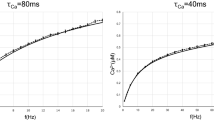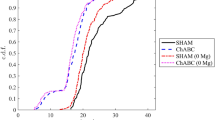Abstract
Synaptic transmission in the brain generally depends on action potentials. However, recent studies indicate that subthreshold variation in the presynaptic membrane potential also determines spike-evoked transmission. The informational content of each presynaptic action potential is therefore greater than initially expected. The contribution of this synaptic property, which is a fast (from 0.01 to 10 s) and state-dependent modulation of functional coupling, has been largely underestimated and could have important consequences for our understanding of information processing in neural networks. We discuss here how the membrane voltage of the presynaptic terminal might modulate neurotransmitter release by mechanisms that do not involve a change in presynaptic Ca2+ influx.
This is a preview of subscription content, access via your institution
Access options
Subscribe to this journal
Receive 12 print issues and online access
$189.00 per year
only $15.75 per issue
Buy this article
- Purchase on Springer Link
- Instant access to full article PDF
Prices may be subject to local taxes which are calculated during checkout


Similar content being viewed by others
References
Alle, H. & Geiger, J. R. Combined analog and action potential coding in hippocampal mossy fibers. Science 311, 1290–1293 (2006).
Shu, Y., Hasenstaub, A., Duque, A., Yu, Y. & McCormick, D. A. Modulation of intracortical synaptic potentials by presynaptic somatic membrane potential. Nature 441, 761–765 (2006).
Kole, M. H., Letzkus, J. J. & Stuart, G. J. Axon initial segment Kv1 channels control axonal action potential waveform and synaptic efficacy. Neuron 55, 633–647 (2007).
Alle, H. & Geiger, J. R. Analog signalling in mammalian cortical axons. Curr. Opin. Neurobiol. 18, 314–320 (2008).
Kole, M. H. & Stuart, G. J. Signal processing in the axon initial segment. Neuron 73, 235–247 (2012).
Werblin, F. S. & Dowling, J. E. Organization of the retina of the mudpuppy, Necturus maculosus. II. Intracellular recording. J. Neurophysiol. 32, 339–355 (1969).
Marder, E. Neurobiology: extending influence. Nature 441, 702–703 (2006).
de Ruyter van Steveninck, R. R. & Laughlin, S. B. The rate of information transfer at graded-potential synapses. Nature 379, 642–645 (1996).
Borst, A. & Theunissen, F. E. Information theory and neural coding. Nature Neurosci. 2, 947–957 (1999).
Heidelberger, R. Mechanisms of tonic, graded release: lessons from the vertebrate photoreceptor. J. Physiol. 585, 663–667 (2007).
Debanne, D., Campanac, E., Bialowas, A., Carlier, E. & Alcaraz, G. Axon physiology. Physiol. Rev. 91, 555–602 (2011).
Bucher, D. & Goaillard, J. M. Beyond faithful conduction: short-term dynamics, neuromodulation, and long-term regulation of spike propagation in the axon. Prog. Neurobiol. 94, 307–346 (2011).
Alle, H., Roth, A. & Geiger, J. R. Energy-efficient action potentials in hippocampal mossy fibers. Science 325, 1405–1408 (2009).
Sengupta, B., Stemmler, M., Laughlin, S. B. & Niven, J. E. Action potential energy efficiency varies among neuron types in vertebrates and invertebrates. PLoS Comput. Biol. 6, e1000840 (2010).
Shimahara, T. & Tauc, L. Multiple interneuronal afferents to the giant cells in Aplysia. J. Physiol. 247, 299–319 (1975).
Shimahara, T. & Peretz, B. Soma potential of an interneurone controls transmitter release in a monosynaptic pathway in Aplysia. Nature 273, 158–160 (1978).
Nicholls, J. & Wallace, B. G. Modulation of transmission at an inhibitory synapse in the central nervous system of the leech. J. Physiol. 281, 157–170 (1978).
Shapiro, E., Castellucci, V. F. & Kandel, E. R. Presynaptic membrane potential affects transmitter release in an identified neuron in Aplysia by modulating the Ca2+ and K+ currents. Proc. Natl Acad. Sci. USA 77, 629–633 (1980).
Zhu, J., Jiang, M., Yang, M., Hou, H. & Shu, Y. Membrane potential-dependent modulation of recurrent inhibition in rat neocortex. PLoS Biol. 9, e1001032 (2011).
Christie, J. M., Chiu, D. N. & Jahr, C. E. Ca2+-dependent enhancement of release by subthreshold somatic depolarization. Nature Neurosci. 14, 62–68 (2011).
Bouhours, B., Trigo, F. F. & Marty, A. Somatic depolarization enhances GABA release in cerebellar interneurons via a calcium/protein kinase C pathway. J. Neurosci. 31, 5804–5815 (2011).
Debanne, D., Guerineau, N. C., Gahwiler, B. H. & Thompson, S. M. Action-potential propagation gated by an axonal IA-like K+ conductance in hippocampus. Nature 389, 286–289 (1997).
Rall, W. Distributions of potential in cylindrical coordinates and time constants for a membrane cylinder. Biophys. J. 9, 1509–1541 (1969).
Sasaki, T., Matsuki, N. & Ikegaya, Y. Effects of axonal topology on the somatic modulation of synaptic outputs. J. Neurosci. 32, 2868–2876 (2012).
Awatramani, G. B., Price, G. D. & Trussell, L. O. Modulation of transmitter release by presynaptic resting potential and background calcium levels. Neuron 48, 109–121 (2005).
Shu, Y., Yu, Y., Yang, J. & McCormick, D. A. Selective control of cortical axonal spikes by a slowly inactivating K+ current. Proc. Natl Acad. Sci. USA 104, 11453–11458 (2007).
Shu, Y., Duque, A., Yu, Y., Haider, B. & McCormick, D. A. Properties of action-potential initiation in neocortical pyramidal cells: evidence from whole cell axon recordings. J. Neurophysiol. 97, 746–760 (2007).
Boudkkazi, S., Fronzaroli-Molinieres, L. & Debanne, D. Presynaptic action potential waveform determines cortical synaptic latency. J. Physiol. 589, 1117–1131 (2011).
Saviane, C., Mohajerani, M. H. & Cherubini, E. An ID-like current that is downregulated by Ca2+ modulates information coding at CA3–CA3 synapses in the rat hippocampus. J. Physiol. 552, 513–524 (2003).
Foust, A. J., Yu, Y., Popovic, M., Zecevic, D. & McCormick, D. A. Somatic membrane potential and Kv1 channels control spike repolarization in cortical axon collaterals and presynaptic boutons. J. Neurosci. 31, 15490–15498 (2011).
Yu, Y., Maureira, C., Liu, X. & McCormick, D. P/Q and N channels control baseline and spike-triggered calcium levels in neocortical axons and synaptic boutons. J. Neurosci. 30, 11858–11869 (2010).
Sasaki, T., Matsuki, N. & Ikegaya, Y. Action-potential modulation during axonal conduction. Science 331, 599–601 (2011).
Debanne, D. & Rama, S. Astrocytes shape axonal signaling. Sci. Signal. 4, pe11 (2011).
Li, L., Bischofberger, J. & Jonas, P. Differential gating and recruitment of P/Q-, N-, and R-type Ca2+ channels in hippocampal mossy fiber boutons. J. Neurosci. 27, 13420–13429 (2007).
Neher, E. & Sakaba, T. Multiple roles of calcium ions in the regulation of neurotransmitter release. Neuron 59, 861–872 (2008).
Zalutsky, R. A. & Nicoll, R. A. Comparison of two forms of long-term potentiation in single hippocampal neurons. Science 248, 1619–1624 (1990).
Salin, P. A., Malenka, R. C. & Nicoll, R. A. Cyclic AMP mediates a presynaptic form of LTP at cerebellar parallel fiber synapses. Neuron 16, 797–803 (1996).
Alle, H., Jonas, P. & Geiger, J. R. PTP & LTP at a hippocampal mossy fiber–interneuron synapse. Proc. Natl Acad. Sci. USA 98, 14708–14713 (2001).
Scott, R., Ruiz, A., Henneberger, C., Kullmann, D. M. & Rusakov, D. A. Analog modulation of mossy fiber transmission is uncoupled from changes in presynaptic Ca2+. J. Neurosci. 28, 7765–7773 (2008).
Eggermann, E., Bucurenciu, I., Goswami, S. P. & Jonas, P. Nanodomain coupling between Ca2+ channels and sensors of exocytosis at fast mammalian synapses. Nature Rev. Neurosci. 13, 7–21 (2012).
Felmy, F., Neher, E. & Schneggenburger, R. Probing the intracellular calcium sensitivity of transmitter release during synaptic facilitation. Neuron 37, 801–811 (2003).
Cooke, J. D., Okamoto, K. & Quastel, D. M. The role of calcium in depolarization-secretion coupling at the motor nerve terminal. J. Physiol. 228, 459–497 (1973).
Llinas, R., Steinberg, I. Z. & Walton, K. Relationship between presynaptic calcium current and postsynaptic potential in squid giant synapse. Biophys. J. 33, 323–351 (1981).
Hochner, B., Parnas, H. & Parnas, I. Membrane depolarization evokes neurotransmitter release in the absence of calcium entry. Nature 342, 433–435 (1989).
Zhang, C. & Zhou, Z. Ca2+-independent but voltage-dependent secretion in mammalian dorsal root ganglion neurons. Nature Neurosci. 5, 425–430 (2002).
Mochida, S., Yokoyama, C. T., Kim, D. K., Itoh, K. & Catterall, W. A. Evidence for a voltage-dependent enhancement of neurotransmitter release mediated via the synaptic protein interaction site of N-type Ca2+ channels. Proc. Natl Acad. Sci. USA 95, 14523–14528 (1998).
Felmy, F., Neher, E. & Schneggenburger, R. The timing of phasic transmitter release is Ca2+-dependent and lacks a direct influence of presynaptic membrane potential. Proc. Natl Acad. Sci. USA 100, 15200–15205 (2003).
Fili, O. et al. Direct interaction of a brain voltage-gated K+ channel with syntaxin 1A: functional impact on channel gating. J. Neurosci. 21, 1964–1974 (2001).
Feinshreiber, L., Singer-Lahat, D., Ashery, U. & Lotan, I. Voltage-gated potassium channel as a facilitator of exocytosis. Ann. NY Acad. Sci. 1152, 87–92 (2009).
Feinshreiber, L. et al. Non-conducting function of the Kv2.1 channel enables it to recruit vesicles for release in neuroendocrine and nerve cells. J. Cell Sci. 123, 1940–1947 (2010).
Parnas, H. & Parnas, I. The chemical synapse goes electric: Ca2+- and voltage-sensitive GPCRs control neurotransmitter release. Trends Neurosci. 30, 54–61 (2007).
Kupchik, Y. M. et al. A novel fast mechanism for GPCR-mediated signal transduction — control of neurotransmitter release. J. Cell Biol. 192 137–151 (2011).
Linial, M., Ilouz, N. & Parnas, H. Voltage-dependent interaction between the muscarinic ACh receptor and proteins of the exocytic machinery. J. Physiol. 504, 251–258 (1997).
Ilouz, N., Branski, L., Parnis, J., Parnas, H. & Linial, M. Depolarization affects the binding properties of muscarinic acetylcholine receptors and their interaction with proteins of the exocytic apparatus. J. Biol. Chem. 274, 29519–29528 (1999).
Kupchik, Y. M. et al. Molecular mechanisms that control initiation and termination of physiological depolarization-evoked transmitter release. Proc. Natl Acad. Sci. USA 105, 4435–4440 (2008).
Ohana, L., Barchad, O., Parnas, I. & Parnas, H. The metabotropic glutamate G-protein-coupled receptors mGluR3 and mGluR1a are voltage-sensitive. J. Biol. Chem. 281, 24204–24215 (2006).
Thompson, S. M. & Gahwiler, B. H. Activity-dependent disinhibition. III. Desensitization & GABAB receptor-mediated presynaptic inhibition in the hippocampus in vitro. J. Neurophysiol. 61, 524–533 (1989).
Kamiya, H., Shinozaki, H. & Yamamoto, C. Activation of metabotropic glutamate receptor type 2/3 suppresses transmission at rat hippocampal mossy fibre synapses. J. Physiol. 493, 447–455 (1996).
Moore, K. A., Nicoll, R. A. & Schmitz, D. Adenosine gates synaptic plasticity at hippocampal mossy fiber synapses. Proc. Natl Acad. Sci. USA 100, 14397–14402 (2003).
He, L. & Wu, L. G. The debate on the kiss-and-run fusion at synapses. Trends Neurosci. 30, 447–455 (2007).
Richards, D. A. Vesicular release mode shapes the postsynaptic response at hippocampal synapses. J. Physiol. 587, 5073–5080 (2009).
Zhang, Q., Li, Y. & Tsien, R. W. The dynamic control of kiss-and-run and vesicular reuse probed with single nanoparticles. Science 323, 1448–1453 (2009).
Blackmer, T. et al. G protein βγ subunit-mediated presynaptic inhibition: regulation of exocytotic fusion downstream of Ca2+ entry. Science 292, 293–297 (2001).
Chen, X. K. et al. Activation of GPCRs modulates quantal size in chromaffin cells through Gβγ and PKC. Nature Neurosci. 8, 1160–1168 (2005).
Bucurenciu, I., Bischofberger, J. & Jonas, P. A small number of open Ca2+ channels trigger transmitter release at a central GABAergic synapse. Nature Neurosci. 13, 19–21 (2010).
Fedchyshyn, M. J. & Wang, L. Y. Developmental transformation of the release modality at the calyx of Held synapse. J. Neurosci. 25, 4131–4140 (2005).
Acknowledgements
The authors are supported by INSERM, Aix-Marseille Université, Centre National de la Recherche Scientifique, Agence Nationale de la Recherche (ANR 11 BSV4 016 01), Fondation pour le Recherche Medicale and the French Ministry of Research. We thank H. Alle, O. El Far, J.-M. Goaillard, V. Marra, M. Seagar and the reviewers for helpful discussion and comments on the manuscript.
Author information
Authors and Affiliations
Corresponding author
Ethics declarations
Competing interests
The authors declare no competing financial interests.
Related links
Rights and permissions
About this article
Cite this article
Debanne, D., Bialowas, A. & Rama, S. What are the mechanisms for analogue and digital signalling in the brain?. Nat Rev Neurosci 14, 63–69 (2013). https://doi.org/10.1038/nrn3361
Published:
Issue Date:
DOI: https://doi.org/10.1038/nrn3361
This article is cited by
-
Brain network communication: concepts, models and applications
Nature Reviews Neuroscience (2023)
-
Toward Analog Neural Computation
Minds and Machines (2018)
-
The role of axonal Kv1 channels in CA3 pyramidal cell excitability
Scientific Reports (2017)
-
Analogue modulation of back-propagating action potentials enables dendritic hybrid signalling
Nature Communications (2016)



